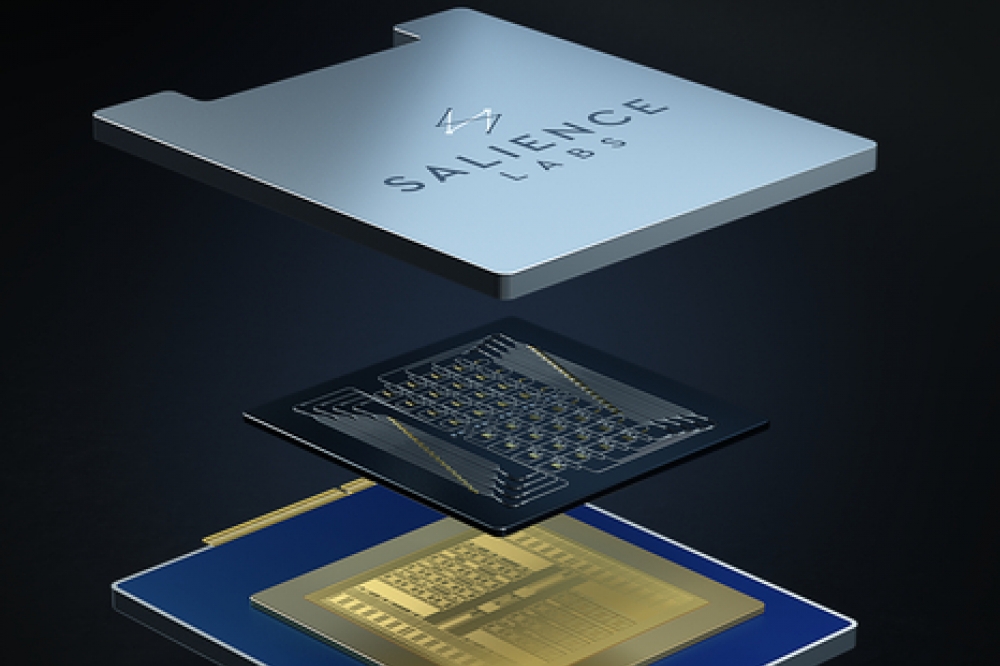Salience Labs Raises $11.5 million to Develop Ultra High-speed AI Chips

Salience Labs has raised a seed round of $11.5 million to develop an ultra high-speed multi-chip processor combining photonics and electronics to accelerate exponential advances in AI. The round was led by Cambridge Innovation Capital and Oxford Science Enterprises, with Oxford Investment Consultants, former CEO of Dialog Semiconductor Jalal Bagherli, Silicon Catalyst, the Goh Family Office in Singapore and Arm-backed Deeptech Labs participating.
Salience Labs’ multi-chip processor, combining photonics and electronics for ultra-high speed AI applications. Credit: Salience Labs
The speed of AI computation doubles every 3.4 months, outpacing what standard semiconductor technologies have left to offer. Meanwhile, AI hardware is moving away from general purpose applications in response to market demands which are increasingly verticalized by use-case. To accelerate exponential advances in AI across industries, a new paradigm for compute – one that is both faster and highly application-specific – is now required.
Salience Labs was spun-out of the University of Oxford and the University of Münster in 2021 to commercialize an ultra high-speed multi-chip processor that packages a photonics chip together with standard electronics. The technology is highly scalable, capable of stacking up to 64 vectors into a beam of light. By using a broad bandwidth of light to execute operations, Salience Labs delivers massively parallel processing performance within a given power envelope.
Salience Labs uses a proprietary amplitude-based approach to photonics, resulting in dense computing chips clocking at 10’s of GHz. This, combined with massively parallel performance, will enable exascale compute in a wide array of new and existing AI processes and applications.
The company leverages multi-chip design, with the photonic processing mapping directly on top of the Static Random Access Memory (SRAM). This novel ‘on-memory compute’ architecture is inherently faster and can be adapted to the application-specific requirements of different market verticals, making it ideal for realizing AI use-cases in communications, robotics, vision systems, healthcare and other data workloads.
Salience Labs’ technology has been designed from first principles for volume manufacture and is currently fabricating with production-level foundries using standard CMOS processes.
Ian Lane, Partner, Cambridge Innovation Capital said, “Salience Labs brings together deep domain expertise in photonics, electronics and CMOS manufacture. Their unique approach to photonics delivers an exceedingly dense computing chip without having to scale the photonics chip to large sizes.”
Alexis Zervoglos, Partner, Oxford Science Enterprises said, “Salience Labs offers a pioneering yet pragmatic solution to the widening gap between AI processing demand and semiconductor industry supply. By leveraging photonics in a novel way, Salience Labs is set to make unprecedented advances in compute, transforming existing AI applications and opening up new addressable horizons.”
Jalal Bagherli, Salience Labs investor and former CEO of Dialog Semiconductor (acq. 2021, Renesas Electronics Corporation, $5.7 billon) said, “The team at Salience Labs is world-class, combining commercial and technical acumen with a disruptive market vision. Their unique ‘on-memory compute’ architecture is ground-breaking, with the potential for breakthrough performance and power capability beyond what the established CMOS roadmap offers.”
Vaysh Kewada, CEO and co-founder of Salience Labs said, “The world needs ever faster chips to grow AI capability, but the semiconductor industry cannot keep pace with this demand. We’re solving this with our proprietary ‘on-memory compute’ architecture which combines the ultra-fast speed of photonics, the flexibility of electronics and the manufacturability of CMOS. This will usher in a new era of processing, where supercompute AI becomes ubiquitous.”


































